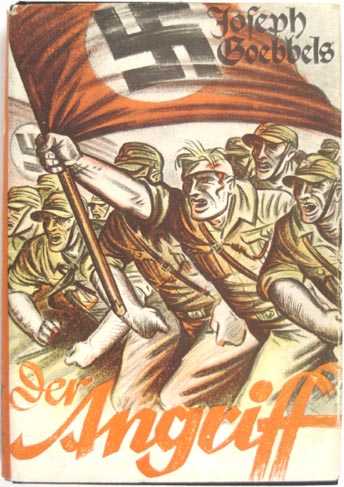


Background: The following essay was published in Der Angriff, 23 January 1928. Goebbels founded the newspaper in Berlin in 1927 shortly after taking over as the party’s leader there. He provides an unappetizing picture of life around the Kaiser Wilhelm Memorial Church, claiming it is filled with depravity, foreigners, and Jews, a place to be avoided by true Germans.
The church stands in the center of Berlin. Built in the 1890s, its ruins today are a reminder today of World War II.
The source: “Rundum die Gedächtniskirche,” Der Angriff. Aufsätze aus der Kampfzeit (Munich: Zentralverlag der NSDAP., 1935), pp. 338-340. The illustration is the book’s dust jacket.
This is Berlin W[est]:
Thousands and thousands of signs beam a flood of light into the gray evening so that the Kurfürstendamm is almost as bright as day. Streetcars jangle, busses rattle past, filled with people, people. Long lines of taxis and elegant limousines fill the mirror-smooth asphalt. Red, yellow, and green stoplights tell traffic to stop and go, and in the midst of it all crossing light signal the dark crowds on the curbs to attempt the dangerous trip from one side to the other. Squeals and commotion assault the ears and he who is not used to it risks losing his senses. Bright red signs announce the latest films: Killed by Love, The Girl from Tauentzien, Just One Night. Whiffs of heavy perfume drift past. Coquettes with the artificial pastels of modern women’s faces smile; so-called men slink around, monocles flashing, false and real gems sparkle. One hears all the languages of earth; here a silent yellow Indian is next to a talkative Saxon, an Englishman elbows his cursing way through the mob and over all the roar a frozen newspaper-seller shouts the latest news from the tabloids.
 In the middle of all the noise of the city, the Gedächtniskirche sends its slender spire into the gray evening. It does not belong in the midst of such raucous life. It is an anachronism standing between the cafes and cabarets, lets the droning autos roll past her stoney body, ignores the rottenness, and rings the hour.
In the middle of all the noise of the city, the Gedächtniskirche sends its slender spire into the gray evening. It does not belong in the midst of such raucous life. It is an anachronism standing between the cafes and cabarets, lets the droning autos roll past her stoney body, ignores the rottenness, and rings the hour.
There are many passers-by who perhaps have never looked up to her spire. The snob in his fur coat and polish saunters past, the woman of the world, a Lesbian from tip to toe, with her monocle, smoking a cigarette, in high heels walks along the sidewalk and disappears into one of the thousands places of smoke and poison whose lights shine invitingly to the evening daylight.
This is Berlin W! The stone heart of this city. Here in the niches and corners of cafes, in cabarets and bars, in Soviet theatres and parlors, intellectuals of the asphalt democracy gather. Here, here is where the politics of sixty million industrious Germans is made. Here one gives and receives the latest tips about the stock exchange and the theatre. Here one manipulates politics, pictures, medical treatments,stocks, love, theatre, the government, and public assistance. The Gedächtniskirche is never alone. She moves smoothly from day to night and night to day without a moment of stillness.
The eternal repetition of rottenness and decay, the lack of genius and true creativity, the hollowness and despair, all coated with the talmi gold of an age that has sunk into the most contradictory pseudoculture: that is what mischief surrounds the Memorial Church. One might wish that the elite of our people were found day and night along Tauentzien Street heading toward God. It is only the Israelite.
The German people is foreign and our-of-place here. One almost stands out when speaking the nation’s language. Pan-Europe, the Internationale, jazz, France, and Piscator [a radical playwright of the era]: that is the theme.
“Die Freundin [a lesbian periodical], old issues, only ten pfennig!” shouts a clever pedlar. None of the passers-by thinks he is in the wrong place. He is not in the wrong place. He knows where he is.
Berlin W is the boil on this great city of work and industry. What is produced in the north is squandered here in the west. Four million people earn their living in this stony waste, and a hundred thousand drones squander their labor in sin, depravity, and filth.
The Kurfürstendamm howls when someone steps on the toes of one of these bloodsuckers; humanity is in danger. The one person they hate to see is an honest working man. Smiling, they carry a whole people to the grave.
That is not the true Berlin. It is elsewhere, waiting and hoping and fighting. It is beginning to recognize the Judas that has sold our people for thirty pieces of silver.
The other Berlin is ready to spring into action. Day and night several thousands are working toward the day that is coming. On that day the places of decay around the Memorial Church will be demolished, transformed, and reintegrated into a risen people.
The day of justice: It will be the day of freedom!
Page copyright © 2016 by Randall Bytwerk. No unauthorized reproduction. My e-mail address is available on the FAQ page.
Go to the German Propaganda Archive Home Page.